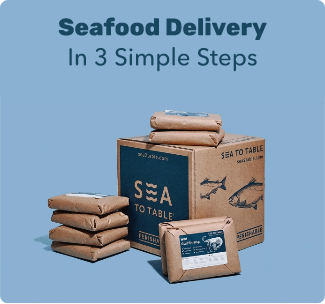The following recipes can be applied to either of our species of Salmon: King or Sockeye. Wild Salmon is leaner than farmed. When cooking, err on the side of underdone to avoid a dry result. Salmon holds up well to most any cooking method, including broiling, baking, poaching, searing, and grilling. Tips for crispy skin can be found here.
Original Seafood Recipes
Wild Gulf Shrimp
Atlantic Sea Scallops
Shucked by hand straight from the ocean, our Atlantic Sea Scallops have a succulent sweet taste and perfectly tender texture. To achieve a perfect sear, make sure to pat your scallops dry beforehand. Pro tip – season both sides with plenty of salt to draw out excess moisture. Coat a skillet in oil or clarified butter and crank up the heat to high. Add the scallops once the oil starts lightly smoking. Avoid fiddling too much. When searing in a pan, let scallops sit (without peeking!) until a golden crust has formed, about 3 mins.
Atlantic Albacore Tuna
Whether you give it a quick touch of heat like our Seared Sesame Crusted Tuna recipe (below) or use this firm and fabulous fish as a substitute for our famous Hawaiian Poke recipe, it's hard to go wrong.
Northwest Pacific Halibut
This meaty, firm fish is mild in flavor, making it suitable for a variety of recipes. Lightly sweet and flaky, it’s great for roasting, grilling, baking and more. Gently pat your fillets with a clean paper towel. The firm white meat of halibut and the mild flavor make this a great fish for any recipe for whitefish. The thing to remember when cooking halibut is that it may dry out fast because of its low oil content. Due to the nature of the fillets, they can hold onto moisture after defrosting. Avoid squeezing. Again, gently pat them dry.
In addition to the recipes below, try substituting this versatile fish in recipes for Fish Sandwiches, Tacos, Baked Fish, or Fish Fingers.
Northwest Pacific Cod
This mild white fish is naturally low in fat, and its lean, flaky meat tastes great plain or with a wide range of cuisines and sauces. In addition to the recipes below, try substituting this versatile fish in our Spring Fish Soup recipe.
Pacific Black Cod
Maine Lobster Tails
Keep lobster tails frozen until ready to use. Thaw lobster tails either overnight in the refrigerator in a drip-proof bowl or tray, or place the bag in cold water to thaw more quickly.
Thoroughly rinse off saltwater glaze (applied in processing to protect the meat), drain and pat dry before using.
Choose your cooking method: baked, grilled, boiled, broiled, or sauteed, the versatility is endless.
Consider not tossing the lobster tail shells in the garbage—save the lobster tail shells to make seafood stock!
Gulf of Maine Redfish
Restaurant chefs and home cooks all over New England embrace their local Gulf of Maine Redfish for its mild, slightly sweet taste and flaky meat. This fish makes a great alternative to other white-meat fish like Snapper, and is extremely easy to cook. Redfish fillets are small and lean, so they cook fast. Remove them from heat when they turn opaque and flake easily with a fork. Tips for crispy skin can be found here.
Northwest Petrale Sole
Northwest Petrale Sole cooks up quickly with sweet, delicate, and flaky fillets that deserve a place on your table. Avoid fiddling too much. Petrale Sole fillets are delicate and can break if they aren’t handled gently. To keep your fillets perfectly intact, try not to flip – if you do, be gentle and use a non-stick pan. Watch for curling. If your fish fillets are curling up in the pan, feel free to apply light pressure with a spatula.
Atlantic Winter Skate
Skate fillets are sweet like scallops, delicate but firm like lobster, and often compared to flounder and sole. Our skin-off fillets are hand-trimmed and fan-shaped, so they make for a uniquely beautiful and delicious plate. Careful not to fiddle too much. Skate fillets are extremely delicate and can break if they aren't handled gently!
Sea Stories
Our blog featuring high sea tales of sustainable seafood.
Seafood Cooking Tips
Defrosting your seafood
The safest, most foolproof way to defrost your fish is under refrigeration. Most of our seafood will thaw completely within 24 hours. Once your fish is thawed, drain any excess liquid, give it a gentle rinse under cold water, pat it dry with a paper towel, and cook right away.
What if you don't have 24 hours to thaw your fish? In that case, try our Quick Thaw Method.
For reasons of food safety and quality, never defrost your fish in the microwave, or on the counter.
How to tell when fish is cooked properly
Check out our primer on cooking fish and how to know when it's done.
How to get crispy skin
We're glad you ask. Click here for our tips on crispy skin and preventing curling.
Air Frying
Here is our post on air-frying fish.
Pan Frying & Deep Frying
Check out this interactive recipe from our innovative friends at Larabee, as well as these additional tips on how to deep-fry and pan-fry your fish.
Grilling
Check out our post on grilling fish.
Poaching
Glad you asked! Here is how.
Is Sea to Table fish “sushi grade”? Is it safe to eat raw?
The term “Sushi Grade” is tossed around frequently, and there are no regulations and standards regarding the use of that term. However, it’s generally used to describe fish of the finest quality and freshness. So in the most used sense of the phrase, yes, Sea to Table fish is sushi grade. But can you eat your Sea to Table fish raw? The answer again is yes (with some important caveats we’ll get to in a minute). FDA guidelines for fish sold for raw consumption be frozen under one of the following conditions to kill any parasites:
- -4°F (-20°C) or below for 7 days (total time)
- -31°F (-35°C) or below until solid, and storing at -31°F (-35°C) or below for 15 hours
- -31°F (-35°C) or below until solid and storing at -4°F (-20°C) or below for 24 hours
Sea to Table’s seafood offerings are flash-frozen, at temperatures as low as -40°F, on the fishing boat or at the dock, eliminating the (very, very small) risk posed by unfrozen fish. But speaking of risk, the most dangers of eating raw fish are created in the home kitchen itself. To avoid cross-contamination and bacteria, always work with scrupulously clean and sanitized equipment, and keep your fish cold… temperature abuse is your biggest risk.
Need ideas for what to do with your raw fish? You could serve it as sashimi, thinly sliced, with a little soy and some wasabi. Or serve it as crudo, with some good olive oil and a finishing salt. Or, if you want a more defined recipe, why not try our gravlax or poke?
What is that white stuff on Salmon?
Albumin is a natural protein that lives in fish in liquid form and appears when the muscle fibers are heated and they contract, pushing out the white-colored protein. It is perfectly safe to eat, but unsightly. Learn how to eliminate it when cooking salmon.
How should I properly handle my Sea to Table seafood?
All of the fish we ship to home delivery customers has been flash-frozen, eliminating any potential parasites. Nonetheless, all seafood, regardless of the source or how it’s treated, may contain bacteria that could cause illness if mishandled or cooked improperly. For your protection, the fish should be kept frozen until you intend to defrost and prepare it right away. Always keep the fish either refrigerated or frozen, and keep it separated from other foods you might be working with. Wash all working surfaces (including cutting boards), utensils and hands after touching raw seafood. Cook thoroughly and refrigerate leftovers immediately after your meal.
How should I dispose of the packaging and dry ice?
Cardboard boxes can be recycled curbside as you would any paper.
Insulation is made from recycled clothing (blue jeans) or waste from clothing manufacturing, and should be discarded in the trash unless your municipality allows textile recycling or composting. The plastic liner for the insulation is polyethylene (#4 LDPE, like a bread bag) and widely recyclable through store collection bins.
Our butcher paper is a special freezer parchment with an artificial wax lining, which should be discarded in the trash, along with plastic vacuum wraps.
Dry ice should be handled very carefully. You should never touch dry ice directly. Please leave overnight to sublimate in a well ventilated space. Outside is preferred, away from animals and children. If you're feeling sciencey, here are 5 Fun Things to Do (carefully) With Dry Ice.
The dry ice should come in protective plastic that can be thrown away and a cardboard box that can be recycled.
How long will fish last in my freezer?
It depends if you are talking about fish you freeze yourself at home, or fish purchased from Sea to Table. Sea to Table fish are flash frozen immediately after landing. Flash freezing is the process of freezing an item quickly at an extremely low temperature. This preserves the food much differently than if you were to take fish from the grocery store and freeze it yourself. Why? Well, quite simply, your home freezer is not designed to freeze foods, it's designed to keep frozen foods cold.
When you put unfrozen foods in your freezer, it takes hours to freeze them fully. During this lengthy time, ice crystals form between the fibers of your fish and actually "break" the fibers and force the nutritious juices right out of your fish.
So, when you thaw out your fish, you'll actually see all the juices that have been forced out of them, and then you’ll end up throwing that out or washing it down the drain. In contrast, Sea to Table’s seafood offerings are frozen (at minus 40 degrees Fahrenheit) so quickly that the ice crystals don't form between the fibers of your fish. When you thaw out our flash frozen seafoods, you will keep all of the nutrients and juices inside the fish, instead of down the drain.
The air-tight packaging also makes a huge difference. All Sea to Table’s offerings are packaged in vacuum-sealed, airtight wrapping to protect against freezer burn, dehydration and discoloration. In fact, we guarantee your fish, properly cared for in your home freezer, will stay at peak quality for up to one year.
I still have questions!
Please visit our FAQ page, or drop us an email at support@sea2table.com. Old-fashioned phone calls work too — (800) 868-2575.

